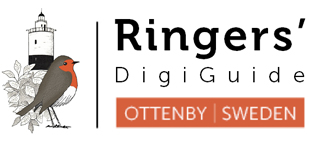

Bohemian Waxwing
AGE – BEST CRITERIA:
Most individuals are easily aged based on the below critera.
1cy:
2cy+:

2cy+ (2cy?) Female, November. SS4-6 retained (a result of an arrested complete moult). In this bird, the retained SS are very worn, bleached and have much poorer quality than the moulted ad-type SS. In addition, the waxy tips are considerably smaller and S4 lacks it altogether. Because of the above, the retained SS are most likely of a worn juv generation which would make the bird a 2cy. [3630975]

2cy+ (3cy+?) Male, November. SS5-6 retained (as a result of an arrested complete moult). The retained SS are more worn and bleached than the new feathers around them, but clearly in much better condition than the retained SS in the previous example [3630975]. In addition, the waxy tips are the same size in the retained SS as in the moulted SS. Therefore the retained SS are most likely of a worn ad generation which would make the bird a 3cy+. [3630995].
More Bombycilla garrulus:
Ringers’ DigiGuide is sponsored by: